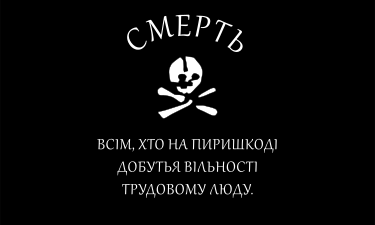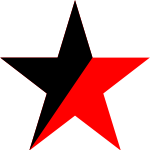Free Territory
| Free Territory | ||||||||||||
| Вільна територія | ||||||||||||
| Stateless territory | ||||||||||||
| ||||||||||||
| Motto "Смерть всім, хто стоїть на перешкоді здобуття вільності трудовому люду!" (Ukrainian) "Death to all who stand in the way of obtaining the freedom of working people!" | ||||||||||||
 Approximate location of the Free Territory in present-day Ukraine | ||||||||||||
| Capital | Huliaipole | |||||||||||
| Languages | Ukrainian Russian | |||||||||||
| Government | Anarcho-communist quasi-stratocracy[1] | |||||||||||
| Military leader | ||||||||||||
| • | 1919–1921 | Nestor Makhno | ||||||||||
| Historical era | Russian Civil War | |||||||||||
| • | Established | 1918 | ||||||||||
| • | Disestablished | 1921 | ||||||||||
| Population | ||||||||||||
| • | est. | 7 million | ||||||||||
| ||||||||||||
| Today part of | ||||||||||||
The Free Territory (Ukrainian: Вільна територія vilna terytoriya; Russian: свободная территория svobodnaya territoriya) or Makhnovia (Махновщина Makhnovshchyna) resulted from an attempt to form a stateless anarchist[1] society during the Ukrainian Revolution of 1917 to 1921. It existed from 1918 to 1921, during which time "free soviets" and libertarian communes[2] operated under the protection of Nestor Makhno's Revolutionary Insurrectionary Army. The area had a population of around seven million.[3]
Russian forces of the White movement under Anton Denikin occupied the territory and formed a temporary government of Southern Russia in March 1920, but in late March 1920 Denikin's forces retreated from the area, driven out by the Red Army in cooperation with Makhno's forces, whose units conducted guerrilla warfare behind Denikin's lines.
As the Free Territory self-organized itself along anarchist principles, references to "control" and "government" are highly contentious. For example, the Makhnovists, often cited as a form of government (with Nestor Makhno as their "leader"), played a purely military role, with Makhno himself functioning as little more than a military strategist and advisor.[4]
History
Establishment
The military role Makhno had adopted in his early years shifted to an organizing one. The first congress of the Confederation of Anarchists Groups, under the name of Nabat ("The Alarm Drum"), issued five main points: suspension of all political parties, rejection of all dictatorships (mainly those organizing over people), negation of any State concept, rejection of any "transitory period" or "proletarian dictatorship", and advocated the self-management of all workers through free workers' councils (soviets).[5] These were in clear contrast to Bolshevik views.
The color that this anarchist group used to distinguish itself was black (the traditional color of anarchism), as that was how its military was described – as opposed to Tsarist "Whites" and Bolshevik "Reds". The principles of governance were laid out in the manifesto published by the Cultural and Educational Section of the Insurrectional Makhnovite Army and widely distributed among the populace with particular attention to peasants and workers.[5]
Development and characteristics
From November 1918 to June 1919, the Makhnovists established an anarchist society run by peasants and workers in Ukraine. The territory under their control stretched approximately between Berdyansk, Donetsk, Alexandrovsk (later known as Zaporizhia), and Yekaterinoslav, (Sicheslav, later Dnipropetrovsk, now Dnipro). According to Makhno, "The agricultural majority of these villages was composed of peasants, one would understand at the same time both peasants and workers. They were founded first of all on equality and solidarity of its members. Everyone, men and women, worked together with a perfect conscience that they should work on fields or that they should be used in housework... The work program was established in meetings in which everyone participated. Then they knew exactly what they had to do". (Makhno, Russian Revolution in Ukraine, 1936).
According to the leaders of the Revolutionary Insurrectionary Army of Ukraine (RIAU), society was reorganized according to anarchist values, which lead Makhnovists to formalize the policy of free communities as the highest form of social justice. Education followed the principles of Francesc Ferrer, and the economy was based on free exchange between rural and urban communities, from crops and cattle to manufactured products, according to the theories of Peter Kropotkin.
The Makhnovists said they supported "free worker-peasant soviets"[6] and opposed the central government. Makhno called the Bolsheviks dictators and opposed the "Cheka [secret police]... and similar compulsory authoritative and disciplinary institutions". He called for "[f]reedom of speech, press, assembly, unions and the like".[6] The Makhnovists called various congresses of soviets, in which all political parties and groups – including Bolsheviks – were permitted to participate, to the extent that members of these parties were elected delegates from worker, peasant or militia councils. By contrast, in Bolshevik territory after June 1918, no non-Bolsheviks were permitted to participate in any national soviets and most local ones,[7] the decisions of which were also all subject to Bolshevik party veto.
A declaration stated that Makhnovist revolutionaries were forbidden to participate in the Cheka, and all party-run militias and party police forces (including Cheka-like secret police organizations) were to be outlawed in Makhnovist territory.[8][9] Historian Heather-Noël Schwartz comments that "Makhno would not countenance organizations that sought to impose political authority, and he accordingly dissolved the Bolshevik revolutionary committees".[10][11] The Bolsheviks, however, accused him of having two secret police forces operating under him.[12]
The Bolsheviks began their formal efforts to disempower Makhno on 4 June 1919 with Trotsky's Order No. 1824, which forbade electing a congress and attempted to discredit Makhno by stating: "The Makhno brigade has constantly retreated before the White Guards, owing to the incapacity, criminal tendencies, and the treachery of its leaders."[5]
Defeat
The Bolshevik government in Petrograd initially allied with Makhno and considered allowing an independent area for Makhno's libertarian experiment.[10] But the Bolsheviks increasingly saw the Makhnovists as a threat to their power, both as an example and as a site of anarchist influence.[13] It restarted a propaganda campaign declaring the Free Territory to be a warlord regime, and eventually broke with it by launching surprise attacks on Makhnovist militias[14] despite the pre-existing alliance between the factions.[15]
The Bolshevik press alleged that leaders in the Free Territory, rather than being elected democratically, were appointed by Makhno's military clique. They also alleged that Makhno himself had refused to provide food for Soviet railwaymen and telegraph operators, that the "special section" of the Makhnovist constitution provided for secret executions and torture, that Makhno's forces had raided Red Army convoys for supplies, stolen an armored car from Bryansk when asked to repair it, and that the Nabat group was responsible for deadly acts of terrorism in Russian cities.[16]
A massive military occupation took place. This suppressed the Makhnovists, the Ukrainian nationalists, and other non-Bolshevik groups. The "Ukrainian Soviet Socialist Republic" was created, which would last until 1991. An underground Makhnovist presence would persist into the 1940s.
See also
Notes
- 1 2 Noel-Schwartz, Heather.The Makhnovists & The Russian Revolution - Organization, Peasantry and Anarchism. Archived on Internet Archive. Accessed October 2010.
- ↑ Skirda, Alexandre, Nestor Makhno: Anarchy's Cossack. AK Press, 2004, p. 86
- ↑ Peter Marshall, Demanding the Impossible, PM Press (2010), p. 473.
- ↑ Skirda, Alexandre, Nestor Makhno: Anarchy's Cossack. AK Press, 2004, p. 34
- 1 2 3 Daniel Cohn-Bendit and Gabriel Cohn-Bendit, The Makhno Movement and Opposition Within the Party
- 1 2 Declaration Of The Revolutionary Insurgent Army Of The Ukraine (Makhnovist). Peter Arshinov, History of the Makhnovist Movement (1918-1921), 1923. Black & Red, 1974
- ↑ Simon Pirani, The Russian Revolution in Retreat, 1920–24: Soviet Workers and the New Communist Elite, Routledge, 2008, p. 96.
- ↑ Nestor Makhno--anarchy's Cossack
- ↑ Declaration Of The Revolutionary Insurgent Army Of The Ukraine (Makhnovist). Peter Arshinov, History of the Makhnovist Movement (1918-1921), 1923. Black & Red, 1974
- 1 2 Avrich, Paul. Anarchist Portraits, 1988 Princeton University Press, p. 114, 121
- ↑ Schwartz, Heather-Noël (January 7, 1920), The Makhnovists & The Russian Revolution: Organization, Peasantry, and Anarchism, archived from the original on 2 Dec 98, retrieved January 18, 2008 Check date values in:
|archive-date=(help) - ↑ Footman, David. Civil War In Russia Frederick A.Praeger 1961, page 287
- ↑ Skirda, Alexandre, Nestor Makhno: Anarchy's Cossack. AK Press, 2004, p. 236
- ↑ Skirda, Alexandre, Nestor Makhno: Anarchy's Cossack. AK Press, 2004, p. 238
- ↑ Skirda, Alexandre, Nestor Makhno: Anarchy's Cossack. AK Press, 2004, p. 237
- ↑ 'The Makhno Myth', International Socialist Review #53, May–June 2007.
Bibliography
- Peter Arshinov, History of the Makhnovist Movement (1918-1921), 1923.
- Skirda, Alexandre, Nestor Makhno: Anarchy's Cossack - The struggle for Free Soviets in the Ukraine 1917-1921. AK Press, 2004


